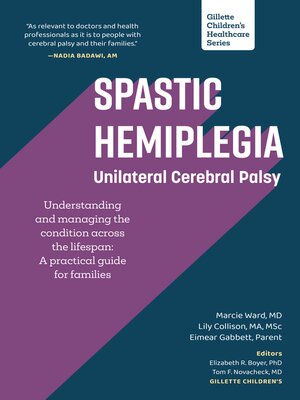Spastic Hemiplegia–Unilateral Cerebral Palsy
ebook ∣ Understanding and managing the condition across the lifespan: A practical guide for families · Gillette Children's Healthcare Series
By Marcie Ward

Sign up to save your library
With an OverDrive account, you can save your favorite libraries for at-a-glance information about availability. Find out more about OverDrive accounts.
Find this title in Libby, the library reading app by OverDrive.



Search for a digital library with this title
Title found at these libraries:
| Library Name | Distance |
|---|---|
| Loading... |
Spastic hemiplegia is a very common subtype of cerebral palsy (CP), and CP itself is the most common cause of childhood-onset physical disability. An estimated 17 million people worldwide have CP. Spastic hemiplegia is also known as unilateral spastic CP or, simply, unilateral CP. Spastic hemiplegia affects the upper and lower limbs of one side of the body. The upper limb is usually more affected than the lower limb. This practical guide addresses spastic hemiplegia across the lifespan and the evidence-based, best-practice treatments. It also includes the lived experience of families.
The writing of Spastic Hemiplegia was led by Marcie Ward, MD, Pediatric Rehabilitation Medicine Physician at Gillette Children's, a world-renowned center of excellence for the treatment of brain, bone, and movement conditions. Spastic Hemiplegia is part of the Gillette Children's Healthcare Series, a series of books for families who are looking for clear, comprehensive information. Health care professionals, educators, students, and extended family members will also benefit from reading Spastic Hemiplegia.
Other titles in the series include:
Changes from previous edition
N/A
About the topic
Cerebral Palsy is a group of conditions caused by an injury to the developing brain, which can result in a variety of motor and other problems that affect how the child functions. As the injury occurs in a developing brain and growing child, problems often change over time, even though the brain injury itself is unchanging.
Spastic hemiplegia affects the upper and lower limbs of one side of the body. The upper limb is usually more affected than the lower limb. Spasticity is the most common type of atypical tone present in individuals with hemiplegia although dystonia can be present as well.







